Hot Stove managing editor Rita Leifhelm grew up in St. James Parish and attended St. James Grade School at 40th and Tracy from 1955 to 1964. What does this have to do with baseball? Check it out.
St. James – Ed Fitzgerald: Earlier this year, my fellow retired partner Larry Ward gave me a book written by Ed FitzGerald (also a retired Kansas City lawyer). Ed’s book, The Summer With the Blues, was published last year, and the cover photo features the St. James Grade School baseball team of 1949. Ed is in the center of the front row.

Ed tells of growing up in a Catholic family and attending parochial schools – St. James for grade school and Lillis for high school. The central story is about the summer of 1950 when Ed snagged a dream job for a 14-year-old. He became the ball boy at the home games for the Kansas City Blues. The team was affiliated with the Yankees, and the Blues roster included several players who went on to the majors, including Bob Cerv, Bill Virdon, Lew Burdette and future Hall of Famer Whitey Ford.
After the season started, a couple of players were sent down to the Blues from the Yankees – future Hall of Famer Johnny Mize for some rehab and Billy Martin to get more playing time. The arrival of Martin was a boon to Ed. Martin would get to the stadium early and have infield practice with Ed and the other teenage workers at the park. This went on for the month Billy was there, and Ed says he was so proud to have been a member of “Billy Martin’s infield.” After Billy was called up by the Yankees, he was often paired with shortstop Phil Rizzuto, the 1950 American League MVP. Below, Martin and Rizzuto.
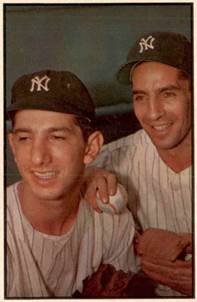
After his initial start as a ball-boy, Ed was called upon to substitute for the visiting clubhouse manager who got drunk and was fired. The position was meant to be temporary because the job was always handled by an adult – taking care of laundry, cleaning the clubhouse, getting concessions for the visiting players (including beer), etc. But Ed did such a good job, he was never replaced that summer. So he got the added benefit of working with the other seven teams of the American Association – players in the farm systems of the Giants, Pirates, Cardinals, etc., many of whom ended up in the majors.
I checked the 1950 rosters in Baseball Reference, and one of players for the St. Paul Saints was George Shuba who was in the Dodgers farm system. Four years earlier, when Shuba was with the Dodgers’ affiliate in Montreal, he famously shook Jackie Robinson’s hand after Jackie’s first homer as a Dodger minor leaguer (photo below). Not every white player was willing to do that. Last year, on the 75th anniversary of the handshake, Shuba’s hometown of Youngstown, Ohio, unveiled a statue commemorating the “Handshake of the Century.”
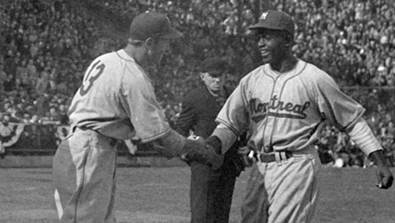
Another player who would have come through Ed’s KC clubhouse was Jimmy Piersall of the Louisville Colonels. Piersall would move up to the Red Sox and become known for his battle with bipolar disorder that was publicized in a book and a film, both titled Fear Strikes Out.
I turned nine that summer of 1950 and was already a baseball nut, listening to Larry Ray broadcasting the Blues on the radio. Boy do I envy what the young Ed FitzGerald did that summer.
Ed’s book is available online at Lulu and Amazon and at Rainy Day Books and other local bookstores.
St. James – Chuck Dobson: In 1950, while Ed FitzGerald was mingling with future major leaguers, Chuck Dobson was finishing his kindergarten year at St. James. Chuck’s parents were members of St. James Parish, and one of his mother’s long-time church friends was Mary Leifhelm. Yes, mother of baby Rita who was born in December of 1949. The small world of Kansas City.
As a kid, Dobson was not into baseball until he picked up a ball one day and threw it through a wall. Dobson suddenly realized he had a strong arm. He joined the St. James baseball team which was being coached by Ed FitzGerald, then a student at Rockhurst College. Ed says that on the first day of practice, Dobson made a throw from the outfield that so impressed him that he installed Dobson at shortstop. The team won the Catholic League city championship that year.
After St. James, Dobson went to De La Salle High School where he was a 3-sport star. He honed his baseball skills in KC’s famed Ban Johnson League (photo below, in his Guy’s Food cap). He pitched in college at KU, played some semi-pro ball, and in 1964 was part of the Team USA tour in the Far East, including a stop in Tokyo for a demonstration game in the Olympics.
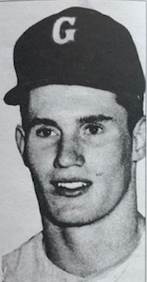
Before Dobson went to the Olympics in 1964, he signed a contract with Kansas City A’s scout Whitey Herzog. It was not announced at the time because of his amateur status for Team USA. Upon return from the Far East tour, his signing was announced. He played in the minors in 1965 and moved up to the A’s in 1966. In 1967, he became part of the regular rotation, finishing with a record of 10-10.
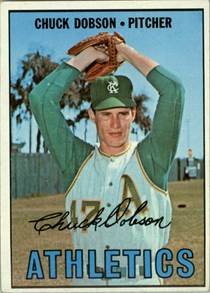
In 1968, the A’s moved to Oakland and Dobson was 12-14 for the season. A major Dobson story in 1968 was his choice of roommate. Although this was some 21 years after Jackie Robinson broke the color line, one tradition still held in MLB – roommates were paired by skin color. Dobson became unhappy with his roommate Jim Gosger and started bunking with Reggie Jackson.
This was a rare occurrence, and some teammates voiced objections, but Dobson was not deterred, saying “Reggie was becoming a star so there wasn’t much anyone could say or do about the situation.” They roomed together for more than two years and developed a mutual respect. Reggie Jackson told the Sporting News, “It’s not a civil rights thing. We get along. We converse.” Below, Reggie’s 1968 card.
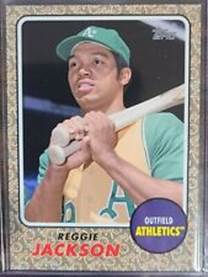
In 1969, Dobson finished 15-13. In 1970, his record was 16-15, and he led the AL in starts (40) and shutouts (5). He was a key player as the A’s were building into a contender. His fellow pitchers included Catfish Hunter and Blue Moon Odom. The offense was led by Reggie Jackson, Campy Campaneris and Sal Bando.
The reverse of his 1970 Topps baseball card depicted the St. James boy striking out 13 Angels in a game. Topps needed an editor – the last line says “Dave is durable and dependable.”
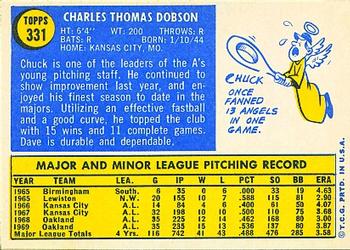
This was corrected on the Spanish language version of the card, “Chuck est durable et stable.”
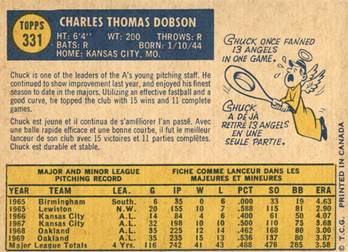
Dobson caused a stir in spring training in 1971 when he became the first active player to admit taking “greenies” on game days. The widespread use of amphetamines (diet pills, pep pills, etc.) in the general population was well known. Even the Pentagon provided millions of the pills to the troops in Viet Nam. The use in sports was long an open secret, and then not-so-secret in baseball with the publication of Jim Bouton’s Ball Four in 1970 (and to less fanfare in Jim Brosnan’s The Long Season in 1960).
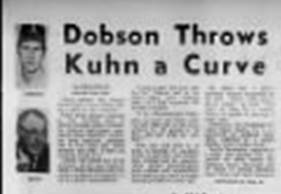
Dobson’s claim that the “whole league was taking amphetamines” did not sit well with Commissioner Bowie Kuhn who demanded that Dobson retract his statements. At first, Dobson responded “I’d like to see him put on a uniform for 162 games in 180 days, and then see what he says.”. But Dobson was also being pressured by owner Charlie Finley and AL president Joe Cronin, so he backtracked and said he’d only taken greenies one time when he had the flu. This was not true, but Dobson wanted to end the controversy. As he said years later for his SABR biography, “They put the fear of God in me…I lied my ass off.”
Dobson went 15-5 in 1971, but he struggled with elbow pain and needed surgery after the season. After winning 68 games for the A’s in the previous five years, he was not a factor in their three World Series Championships in 1972, 1973 and 1974. Released by the A’s after the 1973 season, he played in the Mexican League and then finished MLB play with the Angels in 1974 and 1975. His MLB career stats: 74-69, 3.78 ERA.
Dobson’s post-playing days included coaching, TV sports, modeling, commercials, house painting, bridge, scrabble and world travel. He acknowledged that he was hindered for years by alcoholism, but became sober in the 1980s. To help others, he became an addiction counselor at Welcome House in Kansas City. Years ago, he returned to Kansas City to help his ailing mother, moving back into the house where he grew up in St. James Parish. He died last year on November 30 at the age of 77.
Below, by Jim Murray in the Kansas City Star in 1974 when Dobson was with the Angels.

St. James – Albert Riederer, Tom Turner and Bishop Sullivan Center: I have another baseball story about St. James, but it will take some connecting of the dots.
Albert Riederer (RIP) was a year behind Chuck Dobson at St. James. Albert lacked Dobson’s baseball talent, but he had superb political skills and was a long-time respected officeholder in Jackson County, most notably as prosecutor for 12 years.
Rita was four grades behind Albert at St. James, but did not know him then. Rita and I met Albert through politics in the 1970s and became supporters in his campaigns. We also became good friends with Albert and his wife, Judge Sandy Midkiff. He left us too early, but we have great memories, including New Year’s Eve on December 31, 2011 (From left, Lonnie and Rita, Sandy and Albert, Jane and Woody Overton; photo credit, Pat Titterington) .
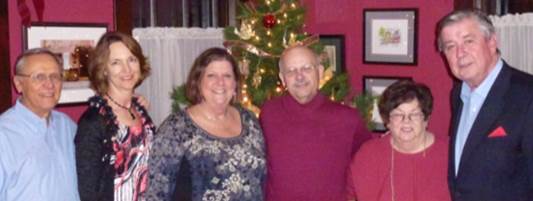
When Albert retired, there was a big tribute party at the Uptown Theater. One of the speakers was Tom Turner, president of Bishop Sullivan Center, the charity Albert had designated for contributions in his honor (the “Albert Fund”). Rita and I were so impressed with Tom’s presentation that we became active supporters of Bishop Sullivan. In another small world connection, Bishop Sullivan operates a food pantry, jobs center and community kitchen in a building that was formerly the activities center for St. James church and grade school. This photo from the 1950s shows Rita’s Brownie troop in the gym at the center (Rita’s mother is the troop leader on the right).
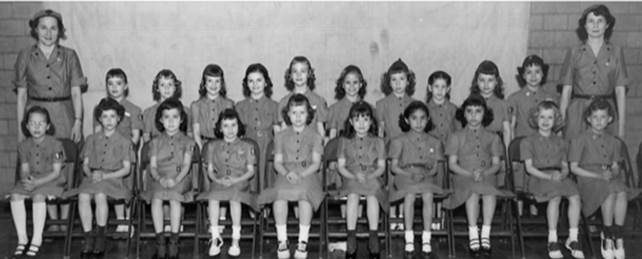
“Where’s Rita?” (in this photo) was a teaser that Wayne Tenenbaum and I used in 2014 to raise funds to buy computers and a walk-in freezer for Bishop Sullivan. In an email blast, we asked friends to guess which Brownie was Rita, and then nudged them for a donation. It was a big success. I’ll let all of you guess too – answer below.
Tom Turner says that when the gym was being converted for use by Bishop Sullivan, one sign from the St. James days was left on the wall. This was done with the specific recognition that the plan was to violate one of the rules. The gym continues to this day to be stacked to the ceiling with supplies for the food pantry.
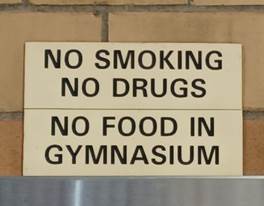
Now some baseball. Tom has been very resourceful in gaining publicity for Bishop Sullivan with pro athletes. For several years, Billy Butler was heavily involved, and one of the big events was an annual pancake breakfast with the participation of Royals players who signed autographs and played whiffle ball with the kids. Below, Billy with some of his Bishop Sullivan fans.

After Billy moved on to the Oakland A’s, Christian Colon succeeded Billy in promoting Bishop Sullivan. Christian and his wife Kayla established a “Go 2 Bat 4 Others” program (his uniform number was 24). One of the initial missions of the program was to ask kids to participate in mini food drives, and the kids were then treated to the pancake breakfast with Royals players. The photo below is from the 2015 breakfast and that’s my grandson Ian with Christian. Ian is now taller than I am.

Current and former players from the Chiefs have also been supporters. Below, at a community barbecue at Bishop Sullivan, Tom Turner stands between two of the servers – Jim Lynch and Jan Stenerud.

In October of last year, Tom retired from Bishop Sullivan Center. After 28 years as director and president, it was time to relinquish the day-to-day administrative demands of a big operation. Though it was not long before he again found himself engaged in helping those in need, this time as the Education Minister at Morning Glory Ministries. The ministry is affiliated with the Cathedral of the Immaculate Conception and serves the poor, needy and homeless in downtown Kansas City. The world needs more Tom Turners.
A baseball anecdote about Tom. When he was nine years old (1965), his father took him to Municipal Stadium to see Campy Campaneris play all nine positions for the Kansas City A’s.

[The answer to “Where’s Rita?” – She is the tall one in the center of the back row. She’s also the tall one in this household.]
St. James – Trophy Patient: In first grade at St. James, Rita met Anne Devaney. They were also classmates in high school at St. Teresa’s Academy and remain best friends to this day. In the Brownies photo, Anne is third from left on the front row, and her mother is the troop leader on the left. Below, from last year (Rita with the hat of course).
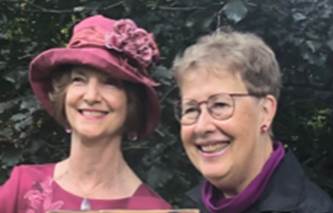
As Hot Stove regulars know, Rita had a hip replacement about two months ago. She promised to be a Trophy Patient, and as her condo-mate, I can testify that has been the case. But she can also be an “impatient patient” – sometimes getting ahead of where the hip was ready to go. The good news is that physical therapy has been productive, and (with a sigh of relief from her husband) she is driving, shopping and cooking again. The best evidence of being on the road to full recovery is that we have walked (at a good pace) two miles at Loose Park.
Rita recently met with Anne and two of their St. Teresa’s classmates, Marilyn Lynch and Suzanne Meyer. The three friends presented the Trophy Patient with a trophy!
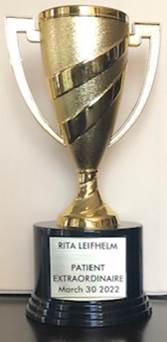
Lonnie’s Jukebox – Lionel Richie Edition: Lionel Richie is on a roll in 2022. Earlier this year, he received the “Gershwin Prize for Popular Song” from the Library of Congress. This coming November, he will be inducted into the Rock and Roll Hall of Fame.
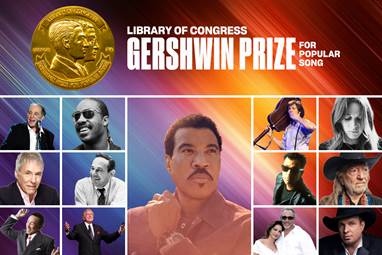
The Gershwin Award goes to singer/songwriters, and Richie has done plenty of both. He joined the Commodores in 1968 as a singer, piano player and saxophonist, and he wrote many of their hits. He also had success writing for other artists such as the Temptations who took his “Happy People” to #1 on the R&B charts in 1974.
He was best known in his Commodores phase for writing and singing ballads that made the Top 10. For example…
“Easy” by the Commodores (1977). Peaked at #4.
“Three Times a Lady” by the Commodores (1978). A #1 hit.
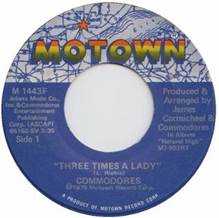
While still performing with the Commodores, Richie wrote two huge hits for Kenny Rogers and Diana Ross (with Richie in a duet).
“Lady” by Kenny Rogers (1980). This was the only #1 solo hit by Kenny Rogers. Three years later, Rogers hit #1 for his duet with Dolly Parton, “Islands In the Stream.”
“Endless Love” by Lionel Richie and Diana Ross (1981). Richie wrote and produced this record, which went to #1 for nine weeks. It was the top selling single in the careers of both Richie and Ross. Billboard has named it the greatest duet of all-time. The success of this record prompted Richie to leave the Commodores in 1982 to pursue a solo career. That also worked out well – five #1 singles and four Top 10 albums.
“All Night Long (All Night)” by Lionel Richie (1983).
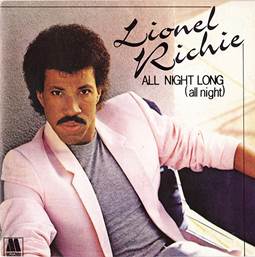
“Say You, Say Me” by Lionel Richie (1985).
“We Are the World” by USA for Africa (1985). This ensemble song was written by Lionel Richie and Michael Jackson to raise funds for Africa famine relief. The single was #1 for four weeks and sold over 20 million copies.
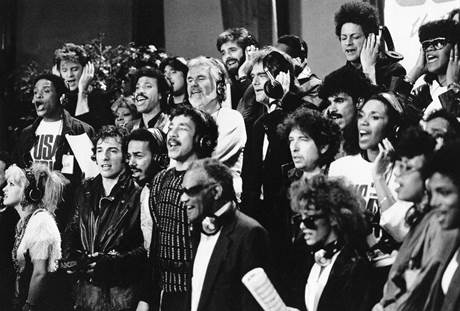
This ensemble was the equivalent of an All-Star baseball team of Ty Cobb, Walter Johnson, Babe Ruth, Lou Gehrig, Josh Gibson, Roberto Clemente, Willie Mays, Mickey Mantle, Hank Aaron, Satchel Paige and Sandy Koufax.
Baseball Hall of Fame meet the Rock and Roll Hall of Fame. Lionel Richie. Paul Simon. Stevie Wonder. Bruce Springsteen. Bob Dylan. Diana Ross. Tina Turner. The great Ray Charles. And so many more. To put names with the faces, click on this link to watch a version of the video that names the singers as they take turns on the lead. What an array of talent.